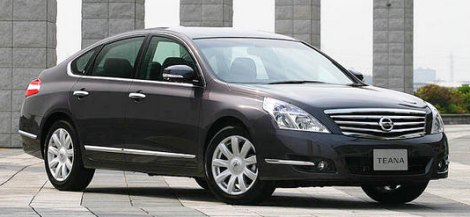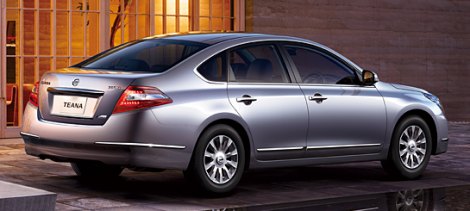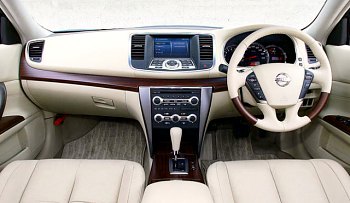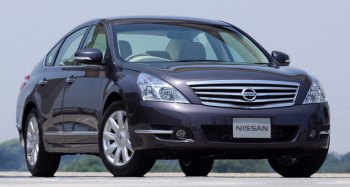Nissan Teana
Debut: 2008 |
||||||||
A sunny weekend, on the country road leading to Lau Shui Heung Reservoir, three Nissans parked nearby. One was a 1999-2003 Cefiro. Its elegant exterior design did not age much, but a look inside found its dashboard outdated and its plastics low-rent. However, the rear seat is still spacious, and the "2.0G" badge at its tail reminded me the creamy smoothness of its first-generation VQ6 engine. Facing the Cefiro was its successor, the 2003-2007 Teana. Time did not improve its styling. On the contrary, it looked fat and slightly odd in some details. Much better was the interior. As its maker claimed, the wood trimmed dashboard and light color leather resembled a comfortable living room, although in terms of pure design it had little to speak of. Teana was bounded in Japan and East Asia market, so its character biased towards comfort. Just a dozen yards away parked another Teana, this time the latest generation. I was amazed how much better it looked versus its predecessor. It is not only better proportioned but also more elegant in details and more precisely assembled. A sneak view of its cabin found the same relaxing living room theme of the old Teana, but now the dashboard is much more stylish, and the quality of materials is markedly improved again. For the first time ever, it led me believe it could be an alternative to German junior executive cars like Audi A4.
Putting Teana and A4 in the same sentence is somewhat strange - they are apple and orange. German junior executive cars are compact, sophisticated and energetic. Japanese ones are big and civilized. This is due to the different requirements of their customers. In the East, size does matter. Small premium cars are seen to be niche, while most company executives want large cars with graceful detailing such as chromed window linings and a prominent grille. Since the termination of Cefiro, Nissan assigned Teana to take care of these customers. The largest market of Teana is China, where 108,000 units were built and sold in 2009. Then there are Japan, India, Thailand, Hong Kong, Singapore, Australia and New Zealand. Demand from these markets justifies the need of building a unique car for them, working against the global trend of "world cars". That said, the Teana is built on the same "D-platform" of the American Nissan Altima and Maxima to share extensive components. D-platform is a light evolution of the outgoing FF-L platform. Its wheelbase is unchanged at 2775mm, while suspensions continue to be MacPherson struts up front and multi-link at the rear. The chassis, however, is strengthened. Torsional rigidity increased by 40 percent, benefiting both handling and refinement. On the road, it feels more agile than the last generation, but that speaks little. By class standards, it still rolls too eagerly in corners. Its 215 section tires give up grip early, thus you get strong understeer when you try to attack corners. This car is still very much oriented to comfort. Cruising on motorway will find the driving experience relaxing. Its steering is light and dull. Its suspension is American-soft, smoothening road undulation very well, but could be caught out by sharp-edge bumps.
The relaxing manner is carried over to its interior. The whole design is simple and easy to use. Light color trimming and panoramic glass roof free up the ambience. The sense quality is also right - not as good as Audi but comfortably above Ford Mondeo. Although the wood and alloy trims do not look very real, they work in harmony with the rest of the design. Space is plenty both front and rear. The leather seats are comfy and supportive - they are made from a vibration absorbing urethane and shaped ergonomically to fit your body. The front seats even get heating and cooling ventilation. Front passenger seat also gets an electrically adjustable calf support. No wonder Teana is so well received in China. Most Teanas on the road are equipped with VQ25DE engine and Xtronic CVT. Compare with the last generation VQ23DE, it gets a couple hundreds of extra c.c. to enable 12 more horsepower and 5 pound-foot more torque for a total of 185hp and 171 lb-ft (both JIS rating). You can sense the extra low-end torque, but still the performance it offers is mediocre - it takes some 9 seconds to go from rest to 60 mph. Fuel economy is also disappointing. I think Nissan should have given it direct injection and VVEL to improve its efficiency and horsepower, but it seems that the company favoured the leanest specifications to reduce cost. Part of the blame must go to the Xtronic CVT, which still gives us mixed impression. On the positive side, this transmission operates seamlessly, as you would expect on a CVT. On the negative side, it fails to tame the disgusting rubber-band effect. Under acceleration, the transmission varies its ratio continuously, keeping the engine screaming at high rev. This hurts its fuel consumption yet generates an unpleasant noise which is hardly proportional to the speed of the car. Yes, you can shift the Xtronic to manual mode which simulates 6 fixed ratios, but even then its response to your input is slow.
Very few Teanas are equipped with the range-topping VQ35DE because it is not offered in most markets. Considering the car is not tuned to be a driver's car anyway, there is hardly any needs for the larger engine. Moreover, with its mild, 252hp tune and the presence of Xtronic, not even the larger engine could do much to our conclusion. The Teana met on Lau Shui Heung road appealed to me in steady state. However, once it is on move, its shortcomings in performance and handling will be revealed. If you are after dynamics, you had better to turn your attention to Ford Mondeo, big Honda Accord, Acura TL or Nissan's own Infiniiti G37. If all you need is a comfortable and graceful-looking executive car, then this one will be worth considering. |
||||||||
| The above report was last updated on 7 Feb 2010. All Rights Reserved. |
| Specifications | ||||||||||||||||||||||||||||||||||||||||||||||||||||||||||||||||||||||||||||||||||||||||
|
||||||||||||||||||||||||||||||||||||||||||||||||||||||||||||||||||||||||||||||||||||||||
| Performance tested by: - |
Copyright©
1997-2010
by Mark Wan @ AutoZine



